1993 CHEVROLET CAMARO washer fluid
[x] Cancel search: washer fluidPage 83 of 358
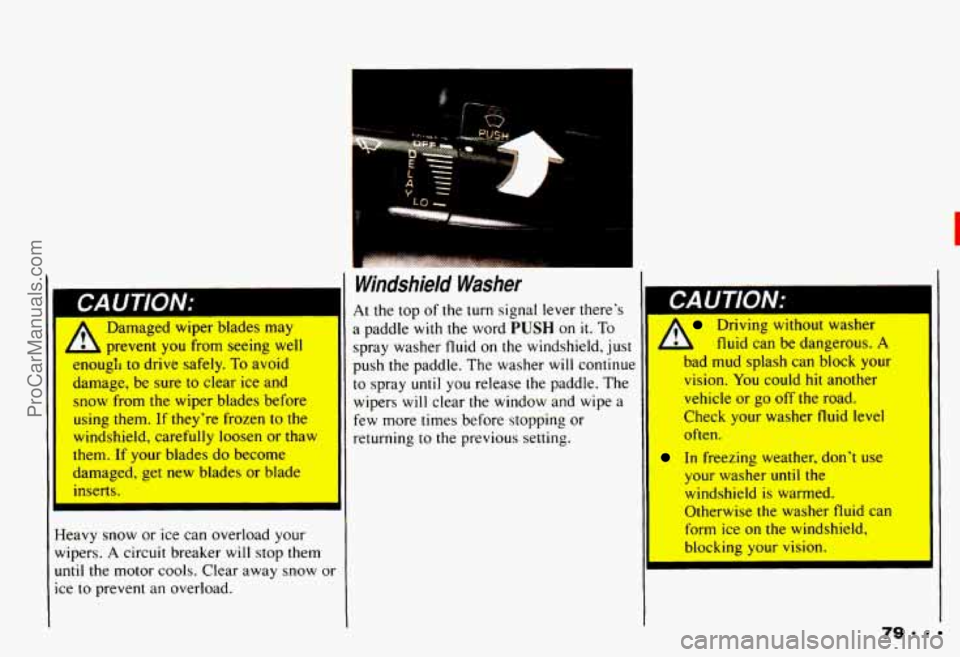
Damaged wiper blades may I
1 prevent you from seeing well
enough to drive safely.
To avoid
damage, be sure to clear ice and
snow from the wiper blades before
using them.
If they're frozen to the
windshield, carefully loosen or thaw
them. If your blades do become
damaged, get new blades or blade
inserts.
Heavy snow or ice can overload your
wipers.
A circuit breaker will stop them
until the motor cools. Clear away snow 01
ice to prevent an overload.
Windshield Washer
At the top of the turn signal lever there's
a paddle with the word PUSH on it. To urlvmg wltnout wasner
spray washer fluid on the windshield, just ' ' L fluid can be dangerous. A
push the paddle. The washer will continue
to spray until you release the paddle. The
wipers
will clear the window and wipe a
few more times before stopping or
returning to the previous setting.
bad mud splash can block your
vision. You could hit another
vehicle
or go off the road.
Check your washer fluid level
often.
In freezing weather, don't use
your washer until the
windshield is warmed.
Otherwise
the washer fluid can
form ice on the windshield,
blocking your vision.
I
79.
ProCarManuals.com
Page 84 of 358
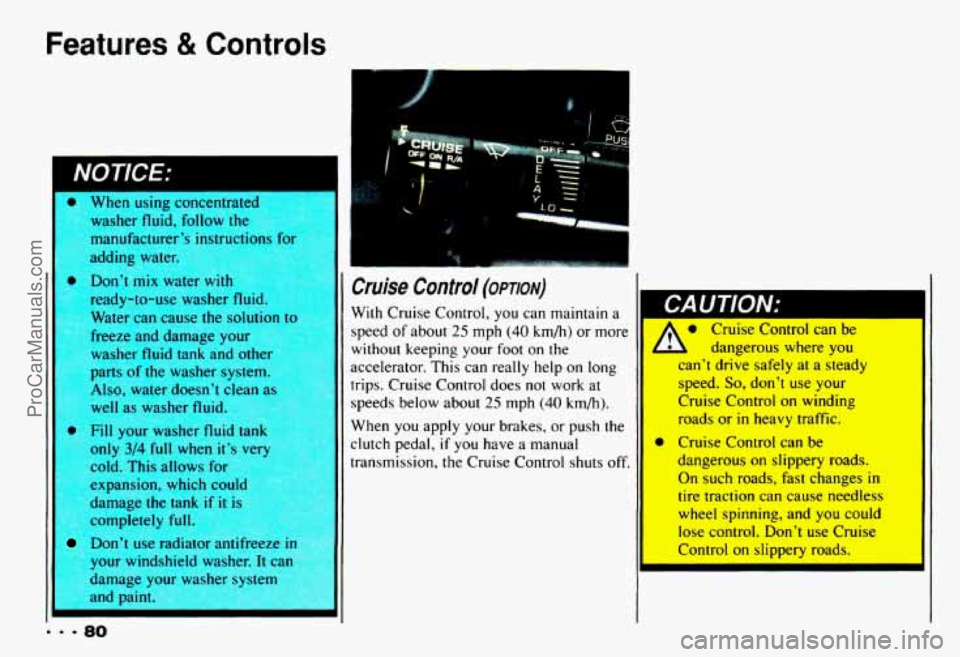
Features & Controls
II
washer fluid, follow the
manufacturer’? instructiopc
fnr
adding water.
Don’t mix warGI with
ready-to-use washer
fluic..
Water can cause the solutinn tn
freeze and damage your
washer
fluid tank and other
parts of the washer systen
Also, water doesn’t clean as
well as washer fluid.
Fill your washer fluid tank
only
3/4 full when it’s ver
cold. This allows
fo
expansion, which COUI(
damage the tank if it is
completely full.
Don’t use radiator anurreeze In
your windshield washer. It can
and paint. damage yolw
wacher cvctpm
-=-8O I
Cruise Control (opmv)
With Cruise Control, you can maintain a
speed of about
25 mph (40 km/h) or more
without keeping your foot on the
accelerator. This can really help on long
trips. Cruise Control does not work
at
speeds below about 25 mph (40 km/h).
When
you apply your brakes, or push the
clutch pedal,
if you have a manual
transmission, the Cruise Control shuts off.
Cruise Control can be
1 L dangerous where you
can’t drive safely at a steady
speed.
So, don’t use your
Cruise Control
on winding
roads or
in heavy traffic.
dangerous
on slippery roads.
On such roads, fast changes in
tire traction can cause needless
wheel spinning, and you
could
lese control. hn’t use Cruise
* Cruise Control can be
ProCarManuals.com
Page 167 of 358

Driving a Long
Distance
Although most long trips today are made
on freeways, there are
still many made on
regular highways.
Long-distance driving on freeways and
regular highways
is the same in some
ways. The
trip has to be planned and the
vehicle prepared, you drive at
higher-than-city speeds, and there are
longer turns behind the wheel. You’ll
enjoy your trip more
if you and your
vehicle are
in good shape. Here are some
:ips for a successful long trip.
Before Leaving on a Long Trip
Make sure you’re ready. Try to be well
rested. If you must start when you’re not
fresh
- such as after a day’s work -
don’t plan to make too many miles that
first part of the journey. Wear comfortable
clothing and shoes you can easily drive
in.
Is your vehicle ready for a long trip? If
you keep
it serviced and maintained, it’s
ready to go. If
it needs service, have it
done before starting out. Of course, you’ll
find experienced and able service experts
in Chevrolet dealerships all across North
America. They’ll be ready and willing to
help
if you need it. Here
are some things you can check
before a trip:
0
0
0
0
0
Windshield Washer Fluid: Is the
reservoir
full? Are all windows clean
inside and outside?
Wiper Blades: Are they in good
shape?
Fuel, Engine Oil, Other Fluids:
Have you checked all levels?
Lights: Are they all working? Are the
lenses clean?
Tires: They are vitally important to a
safe, trouble-free trip.
Is the tread
good enough for long-distance
driving? Are the tires all inflated to
the recommended pressure?
163 -
ProCarManuals.com
Page 174 of 358
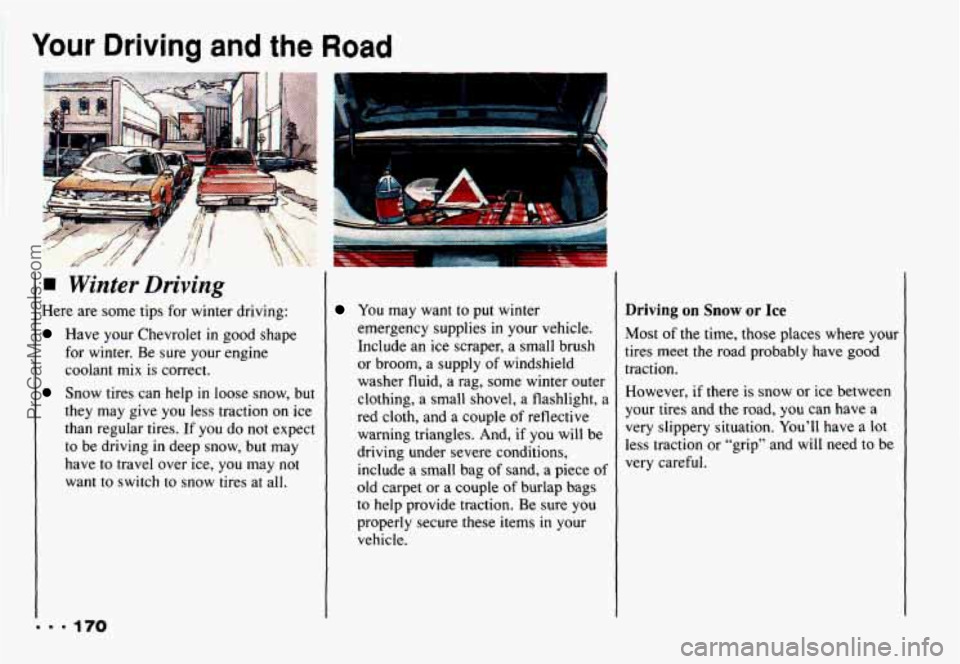
Your Driving and the Road
Winter Driving
Here are some tips for winter driving:
Have your Chevrolet in good shape
for winter. Be sure your engine
coolant mix is correct.
Snow tires can help in loose snow, but
they may give
you less traction on ice
than regular tires.
If you do not expect
to be driving in deep snow, but may
have to travel over ice, you may not
want to switch
to snow tires at all.
You may want to put winter
emergency supplies in your vehicle.
Include an ice scraper, a small brush
or broom, a supply
of windshield
washer fluid, a rag, some winter outer
clothing, a small shovel, a flashlight, a
red cloth, and a couple
of reflective
warning triangles. And, if you will be
driving under severe conditions,
include a small bag of sand, a piece of
old carpet or
a couple of burlap bags
to help provide traction. Be sure you
properly secure these items in your
vehicle.
Driving on Snow or Ice
Most of the time, those places where your
tires meet
the road probably have good
traction.
However, if
there is snow or ice between
your tires and the road, you can have a
very slippery situation. You’ll have a lot
less traction or “grip” and will need to
be
very careful.
ProCarManuals.com
Page 221 of 358

Part b
Here you will find information
about the care
of your Chevrolet .
This part begins with service and
fuel information. and then it shows
how
to check important fluid and
lubricant levels
. There is also
technical information about your
vehicle. and a section devoted to
its appearance care
.
Service & Appearance Care
Service .......................................................... 218
Fuel
............................................................ 219
Checking Things under the Hood
..................................... 223
HoodRelease
................................................... 223
Engineoil
...................................................... 226
Aircleaner
..................................................... 230
Automatic Transmission Fluid
...................................... 233
Manual Transmission Fluid
........................................ 235
Hydraulicclutch
................................................ 237
RearAxle
...................................................... 237
Enginecoolant
.................................................. 238
Power Steering Fluid
............................................. 242
Windshield Washer Fluid
.......................................... 243
Brake Master Cylinder
............................................ 244
Battery
........................................................ 246
Bulb Replacement
................................................. 247
Loading Your Vehicle
.............................................. 255
Appearance Care and Maintenance Materials
............................ 274
Vehicle Identification Number (VIN)
.................................. 275
Service Parts Identification Label
..................................... 275
Add-on Electrical Equipment
........................................ 275
Fuses and Circuit Breakers
.......................................... 276
Replacement Bulbs
................................................ 279
Capacities and Specifications
......................................... 280
Tires
............................................................ 256
Appearancecare
.................................................. 265
217
ProCarManuals.com
Page 228 of 358
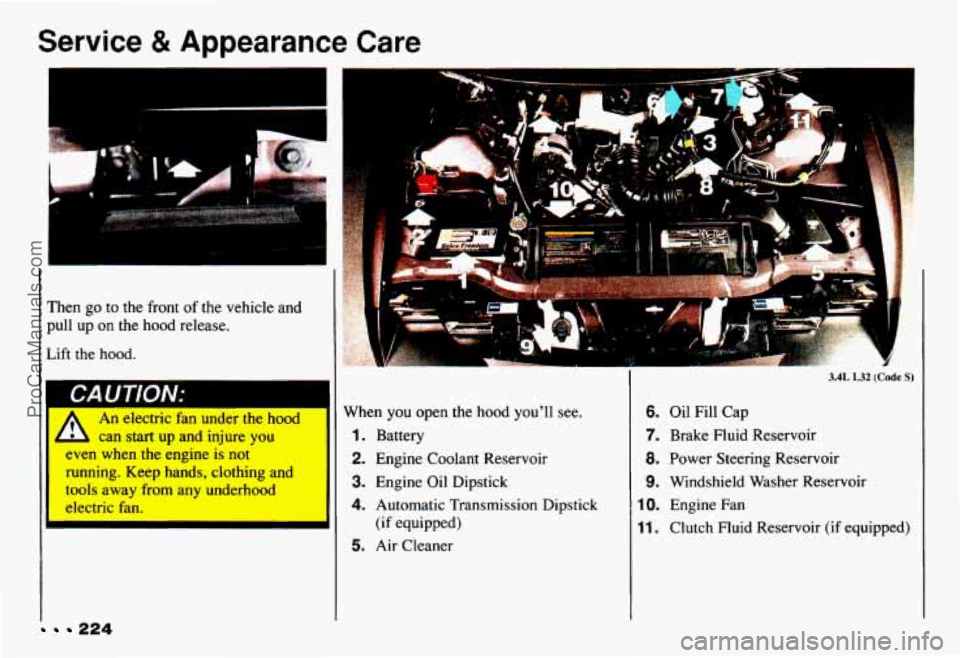
Service 8t Appearance Care
c
Then go to the front of the vehicle and
pull up on the hood release.
Lift
the hood.
I
I CAUTION:
An electric fan under the hood
can start up and injure you
even when
the engine is not
running. Keep hands, clothing and
tools away from any underhood
* xtric fan.
I
Y
3.4L L32 (Code S)
When you open the hood you'll see.
1. Battery
2. Engine Coolant Reservoir
3. Engine Oil Dipstick
4. Automatic Transmission Dipstick
5. Air Cleaner
(if equipped)
6. Oil Fill Cap
7. Brake Fluid Reservoir
8. Power Steering Reservoir
9. Windshield Washer Reservoir
10. Engine Fan
11. Clutch Fluid Reservoir (if equipped)
224
ProCarManuals.com
Page 229 of 358
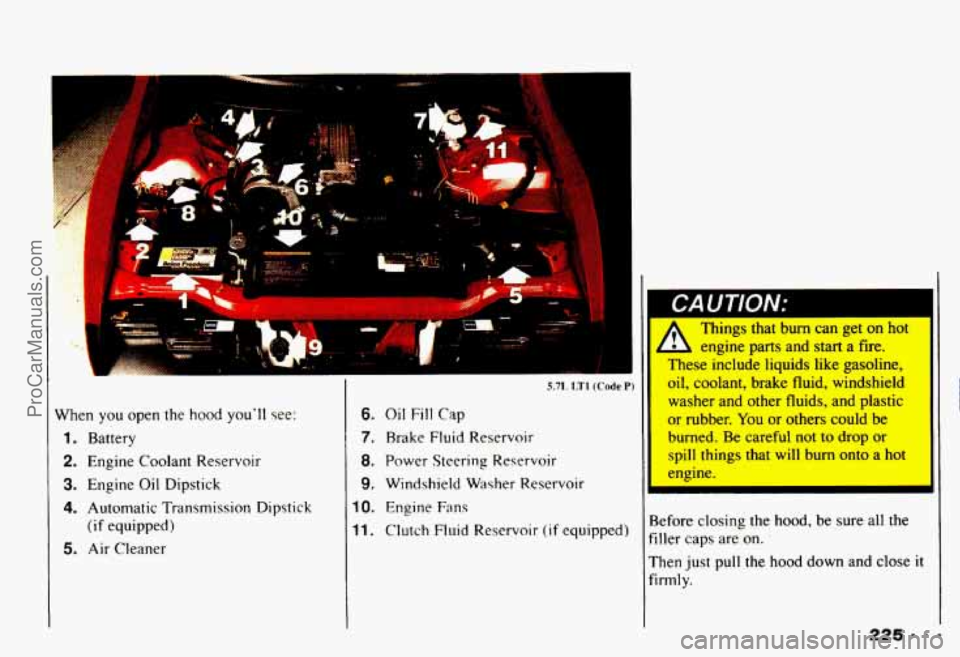
\I I
-:E= 1
f
I
When you open the hood you'll see:
1. Battery
2. Engine Coolant Reservoir
3. Engine Oil Dipstick
4. Automatic Transmission Dipstick
5. Air Cleaner
(if equipped)
II
6. Oil Fill Cap
7. .Brake Fluid
Reservoir
8, Power Steering Reservoir
9. Windshield Washer Reservoir
10. Engine Fans
11. Clutch Fluid Reservoir (if equipped) Things that
burn
can get on hot
b engine parts and start a fire.
mese include liquids like gasoline,
oil, coolant, brake fluid, windshield
washer and other fluids, and plastic
or rubber. You or others could be
burned. Be careful not to drop or
spill things that will burn onto a hot
ennine. 1
Before closing the hood, be sure all the
filler caps are on.
Then just pull the hood down and
close it
firmly.
ProCarManuals.com
Page 247 of 358
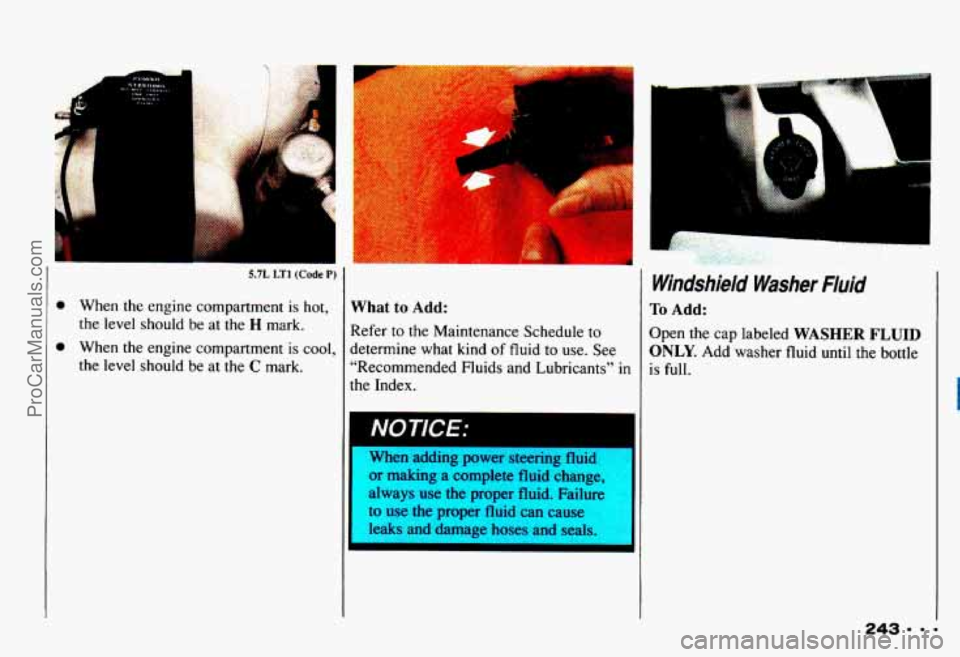
0
0
5.7L LTl (Code P)
When the engine compartment is hot,
the level should be at the
H mark.
When the engine compartment is cool,
the level should be at the
C mark.
;.,,
What to Add:
Refer to the Maintenance Schedule to
determine what kind of fluid to use. See
“Recommended Fluids and Lubricants”
in
the Index.
11 NOTICE: t
When adding power steering fluid
or making a complete fluid change,
always use
the proper fluid. Failure I
to use the proper fluid can cause
leaks and damage hoses and seals.
Windsmeld Washer Fluid
To Add:
Open the cap labeled WASHER FLUID
ONLY. Add washer fluid until the bottle
is full.
ProCarManuals.com